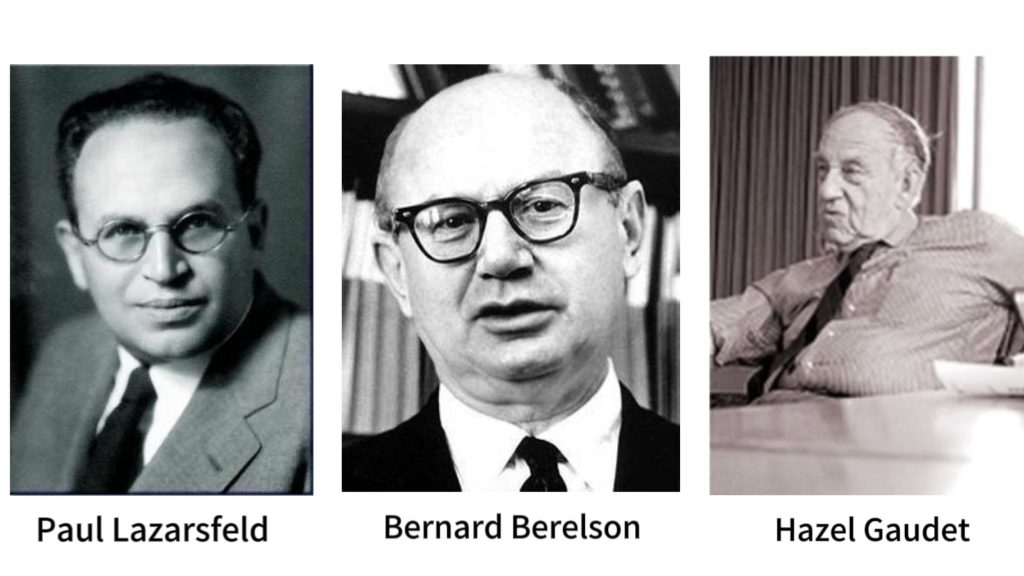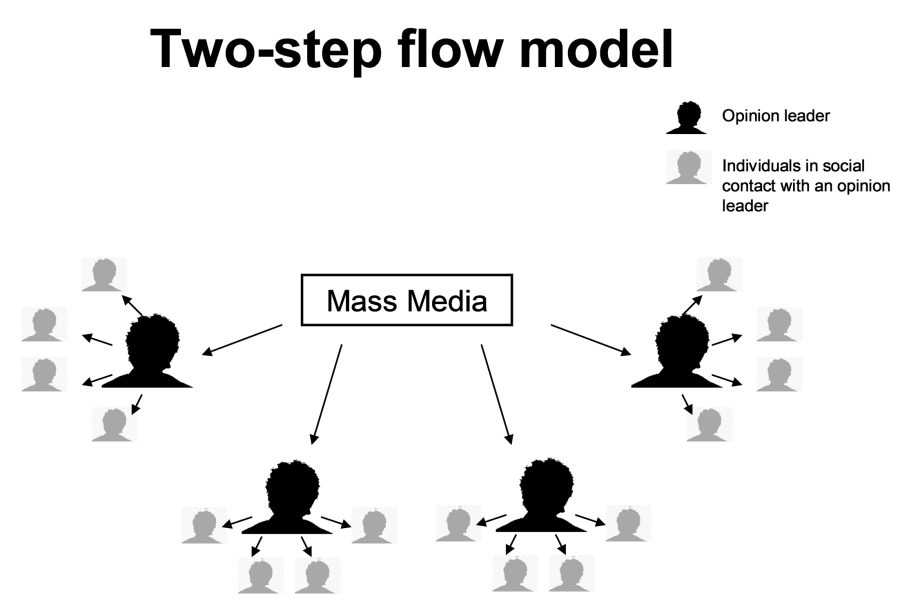History:
The Two-step flow model was developed by Paul Lazarsfeld, Bernard Berelson, and Hazel Gaudet in their book People’s Choice after studying the decision-making process and results of voters during the 1940 U.S. presidential election.
All three researchers wanted to see if mass media messages could influence the direct impact of people’s voting decisions. Surprisingly, they found that media messages, such as radio and newspapers, had much less impact on informal personal communication of voting behavior. Most voters in an election get their information about the presidential candidates not directly from the media, but from others who get information about the campaigns in newspapers or on the radio.

Theoretical introduction:
The Two-step flow model states that most people are not directly influenced by mass media, but form their opinions according to opinion leaders who interpret the media information and put it in context, and interpret it according to the opinion leaders’ own opinions. Opinion leaders then begin to infiltrate those opinions through the public who become “opinion followers.” In other words, the active user media, who collects and interprets the meaning of communicating media information to less active media consumers. This means that most people get their opinion leaders’ information through interpersonal communication rather than directly from mass media.
Opinion Leaders:
So, what is an opinion leader?

Opinion leaders constitute an important source of information and influence in the team, and can influence the attitude of the majority of the minority. Opinion leaders are often well-informed, resourceful, or have certain interpersonal skills to gain recognition and become opinion leaders for the public.
Lazarsfeld and Katz found that people’s responses to media messages are modulated through interpersonal communication with members of their social environment. A person’s membership in different social groups (such as family, friends, professional and religious associations, etc.) has a greater influence on that person’s decision-making process and behavior than information from the mass media.
Example:
Each group has an opinion leader for each group. In the office, the general manager is the opinion leader. In public, the government is the opinion leader.

Of course, there are opinion leaders in media operations and advertising marketing. Companies often use certain characters to endorse the brand they are associated with. For example, a sports drink company will use a celebrity athlete to endorse the brand. When the athlete talks about how much he loves the sports drink and the benefits it brings, this will lead to more people buying the sports drink because of his words. And the athlete is the brand’s opinion leader.
Criticism:
The Two-step flow model received some criticism in the 1970s and 1980s.
- Some researchers believe that the dissemination process of the two-step flow model is oversimplified, and the actual flow of information from mass media to media consumers is more than Two steps.
- The Two-step flow model was developed at a time when communication software, such as television and the Internet, did not exist. But later studies of the TV-dominated era suggest otherwise. It is found that people rely more on mass media than personal communication as their main source of information.
In conclusion:
The influence of the Two-step flow model was so profound that it is still used today. This theory is important for PR professionals because they must consider opinion leaders when creating campaigns.
Reference:
https://www.britannica.com/topic/two-step-flow-model-of-communication


Introduced the theory well with good example and clear structure. i think you can include some of your own thoughts or analytics to expand the example part.
Thank you very much for your comments. The example in my article is to search through my own ideas, and this example represents my view on this theory that has been used so far.
You provide a comprehensive overview of the Two-Step Flow model’s history, application, and criticisms. It’s still credible to see how this theory, developed in the 1940s, remains relevant today, especially in the context of public relations and marketing. The discussion of opinion leaders and their impact on information spread particularly makes people think deeply. And the example given is also appropriate. Good job! рЯШН
Thank you so much.рЯТЧ
I totally agree with your point of view. I also feel that the “two-step flow theory” is of great significance to understanding information dissemination and the role of opinion leaders, especially for public relations professionals, because they need to consider the important role of opinion leaders in activities and communication.
YeahпљЮI agree with you.